There have been many wars since 1945, from the Korean War in the 1950’s to the present-day unrest in the Middle East. Here are some stories – both true and fictional – that can help us imagine the lives of other people.
Stories about the Israeli-Palestinian conflict: HERE
“You can only understand people if you feel them in yourself.” John Steinbeck
Abdel-Fattah, Randa. Where the Streets Had a Name. Scholastic Press, 2010, c2008.
Alabed, Bana. Dear World: A Syrian Girl’s Story of War and Plea for Peace. New York: Simon & Schuster, 2017.
In the news, we hear of the civil war in Syria. On television, we see pictures of the devastated cities. But what is it like to be a child living in the midst of all that chaos? In September of 2016, a seven-year-old girl started telling the world using a Twitter account. And now, in this book, she tells more about her family’s journey from peaceful hope to constant fear. Interspersed with sections providing background information written by her mother, Bana describes a happy childhood that turns into a nightmare that only begins to end when the family flees to Turkey.
Highly recommended for readers twelve years old and up who have read stories and true-life accounts of suffering in World War 2 and are ready to become informed about current events in the world. [Civil war; Refugees; Syria]
Albus, Kate. A Place to Hang the Moon. New York: Holiday House, 2021.
Three orphaned siblings – 12-year-old William, 11-year-old Edmund, and 9-year-old Kate – are evacuated from London during World War II and sent to live in the countryside.
You may have read other stories about British WW 2 evacuees: Good Night, Mr. Tom by Michelle Magorian; The Sky is Falling by Kit Pearson; and The War that Saved My Life by Kimberly Brubaker Baker. You may have read other stories about orphans: Anne of Green Gables by L.M. Montgomery; the Harry Potter series by J.K. Rowling; Pine Island Home by Polly Horvath. The list of stories could go on and on and on. So why read this new novel by Kate Albus?
A Place to Hang the Moon is as heartwarming as stories by Beverly Cleary and Eleanor Estes. It is as unflinching in its description of hardships as novels by Avi and Karen Hesse. Kate Albus’s three protagonists display all the determination and resilience found in the best of children’s stories. Recommended for readers 9 to 12 years old.
Al-Windawi,Thura. Thura’s Diary. New York: Puffin, 2004.
Thura was nineteen years old when the Americans invaded Baghad, Iraq. She had been studying to be a chemist but now she had to stay home. And after the war, life did not improve even though Saddam Hussein was no longer in power. This autobiographical account is recommended for readers 12 years old and up.
Almond, David. Raven Summer. Delacorte Press, 2008.
All of Almond’s novels are for readers with speculative minds. “What if. . .” is always the question that changes the course of what might have been a straight-forward realistic novel. And in this novel, the question is “What if an abandoned baby leads to children who have lived through horrific acts of war? What shall we do? Send them back to their nightmares?” Since Almond is a British writer, some of the references will not be familiar to Canadian students. Nevertheless, this story full of surprises will intrigue readers aged eleven and up.
Banks, Lynne Reid. Broken Bridge. London: Hamish Hamilton, 1995.
Two fourteen-year-olds, recently arrived in Israel walk unsuspectingly thorough the streets of Jerusalem. Two men jump out of a doorway and pounce on them. A few agonizing seconds later, one of the teenagers lies dead from he stab of a terrorist’s knife.
Barakat, Ibtisam. Tasting the Sky: A Palestinian Childhood. Farrar, Straus and Giroux, 2007.
A true story of growing up in Ramallah after the 1967 Six-Day War. [Arab-Israeli conflict; Brothers and sisters; Family life; Middle East; Children, Palestinian]
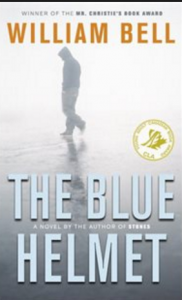
Bell, William. The Blue Helmet. N.p.: Doubleday Canada, 2006.
Lee wants to become a member of the biggest, most powerful gang in his neighbourhood. But when his initiation goes wrong and the police catch him robbing an auto supply store, Lee’s father sends him to live with his aunt in New Toronto [where he meets a former peacekeeper who was stationed to Bosnia]. (back cover)
Bell, William. Forbidden City. Doubleday Canada, 1990.
Forbidden City by William Bell (Doubleday Canada, 1990) is a story about a sixteen-year-old boy named Alexander, enthusiastic and out-going, with a fascination for war-related strategies and important generals. One of his favourite hobbies is making soldiers out of clay. When his father goes to China, he is excited to go along but that’s when a dilemma happens. He is caught in a student protest and has to choose whether to help the students – and risk being hurt, wounded, or killed by the government armies – or to run and flee from the soldiers. He gets caught and sent back to Americ where he writes Forbidden City to cope with his pain. (Caleb in grade eight)
Bondoux, Anne-Laure. A Time of Miracles. New York: Delacorte Press, 2010.
“In the early 1990s, a boy with a mysterious past and the woman who cares for him endure a five-year journey across the war-torn Caucasus and Europe, weathering hardships and welcoming unforgettable encounters with other refugees searching for a better life.” – CIP. Includes a map tracing the journey. A memorable novel of suspense and survival by an outstanding author. Translated from the French by Y. Maudet. [Caucasus; France; Historical fiction; Refugees; Secrets; Survival]
Bunting, Eve. Gleam and Glow. Toronto: Harcourtbooks, 2001.
After his home is destroyed by war in Bosnia-Herzegovina, eight-year-old Viktor finds hope in the survival of two very special fish. This picture book is based on a true story.
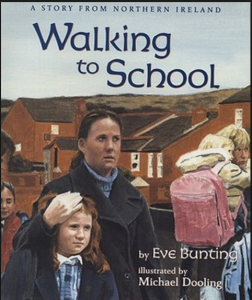
Bunting, Eve. Walking to School. New York: Clarion Books, 2008.
In this picture book set in Belfast, Ireland, eight-year-old Allison has to walk through a Protestant neighbourhood to get to her Catholic school.
Carmi, Daniella. Samir and Yonatan. New York: Scholastic, 2000.
Two injured boys, one Palestinian and one Jewish, find themselves side by side in the same Israeli hospital. Slowly, together with the other patients in the children’s ward, they overcome their fears and form an unexpected friendship.
Carter, Anne L. The Shepherd’s Granddaughter. Toronto: Groundwood, 2008.
Amani, a Palestinian girl, lives with her extended family in a small village. After her beloved grandfather dies, Israeli settlers intrude upon their land. Some family members want to fight back, others say to be more patient and Amani has to decide upon her own future.
Clinton, Cathryn. A Stone in My Hand. Candlewick Press, 2004, c2002.
Eleven-year-old Malaak and her family are touched by the violence in Gaza between Jews and Palestinians when first her father disappears and then her older brother is drawn to a radical group. [FVRL]
Coates, Jan L. A Hare in the Elephant’s Trunk. Red Deer Press, 2010.
Jacob flees when war comes to his Southern Sudan village in 1987. He spends months on the run and years in refugee camps but somehow survives to tell his story and start a new life in Canada. Based on the experiences of Jacob Deng, this informative novel will be appreciated by readers who prefer ‘real’ stories. [Sudan; Refugees; Deng, Jacob; War; Historical fiction]
Cole, Tom Clohosy. Wall. Somerville, Mass.: Templar Books, 2014.
In 1961, families found themselves suddenly separated by the Berlin Wall. East Berlin was under Communist rule and people were not permitted to cross the wall and join their relatives in the West. In this evocatively illustrated picture book, a young boy is determined to find a way for his family to be reunited. Told from the first person point of view and based on true stories, Wall is recommended for readers 8 years old and up. (Artists interested in seeing how to depict night-time scenes may appreciate analyzing the illustrations which were created digitally but provide ideas for working with pastels.) [Berlin Wall; Cold War; Fathers; Historical fiction]
Collins, Suzanne. Year of the Jungle: Memories from the Homefront. New York : Scholastic Press, 2002.
Suzy spends grade one worrying about her father, serving in the American army in Vietnam, and imagining his life through the postcards she receives. Based on the author’s own memories of her father. Recommended for readers eight years old and up. [Father and daughters; Soldiers; Vietnam War]
Combres, Elisabeth. Broken Memory. Groundwood Books, 2007.
Translated from French by Shelley Tanaka, this young adult novel tells the story of fourteen-year-old Emma who sets out to discover the truth behind the nightmares that started when she was five years old, running away after hearing her mother slaughtered during the genocidal war in Rwanda. This short emotionally powerful novel is best suited for mature readers in grades six and up. [Rwanda; Genocide; Historical fiction; War; Orphans; Post-traumatic stress disorder; Courage; Survival]
Cooney, Caroline B. Diamonds in the Shadow. Delacorte, 2007.
Jared is irritated to learn that his family will be taking in an African refugee family sponsored by his church. He and his younger sister will both have to share their bedrooms which seems entirely unfair. His irritation turns to suspicion and astonishment, though, when he discovers the horrors the newcomers have left behind. Or have they left them behind? This novel for mature readers could be compared to Almond’s Raven Summer or Ellis’s No Safe Place. [Africa; Nigeria; Refugees; Immigrants; Connecticut; Civil War; Family life; Compassion; Courage; Criminals]
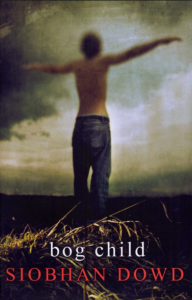
Dowd, Siobhan. Bog Child. New York: Random House, 2008.
In 1981, the height of Ireland’s ‘Troubles,’ eighteen-year-old Fergus is distracted from his upcoming A-level exams by his imprisoned brother’s hunger strike, the stress of being a courier for Sinn Fein, and dreams of a murdered girl whose body he discovered in a bog. (CIP) For mature readers only due to subject matter.
Ellis, Deborah. No Safe Place. Groundwood Books/House of Anansi Press, 2010.
Fifteen-year-old Abdul and two other young migrants, meet in a boat adrift in the English Channel. For mature readers due to sexual references and violence. [Refugees; France; England; Voyages and travels; Courage; Criminals; Runaways]
Ellis, Deborah. The Breadwinner. Vancouver: Douglas & McIntyre, 2000.
Because the Taliban rulers of Kabul, Afghanistan, impose strict limitations on women’s freedom and behavior, eleven-year-old Parvana must disguise herself as a boy so that her family can survive after her father’s arrest. (OhioLINK) There are two more books in this series: Parvanna’s Journey and Mud City.
Parvana, in Parvana’s Journey by Deborah Ellis (Douglas and Mclntyre, 2001), is a teenage girl whose father is dead and her mother and siblings are on the other side of Afghanistan. Parvana feels miserable hungry, tired, and scared. Has she been the cause of all the problems that have been happening to her and her family? She comes across an abandoned baby child in an old village. A few days later she comes across an old cave with a young boy with one leg in the middle of the desert, Parvana feels responsible for those kids, so after a little thinking she takes them with her on her journey to find her family. Will she be able to take care of herself and the two boys? Will she find her family in one piece? Will she even survive in the desert? Read this fascinating novel of adventure and survival to find out!
What images are especially vivid in my mind after reading this novel? There are many memorable scenes. I recall the horror on Parvana face when her father died, she was so depressed and she wouldn’t take in the fact that her father was gone. I remember when parvana was walking for endless hours to find some food or water, it kind of made me hunger and thirsty. I also start worrying about how much food we have! I also get sad when I remember how hard Parvana’s condition was and when I think of her it kind of reminds me of all those poor people living horrible lives in Afghanistan. I still feel a bit depressed when i think of how she had to sacrifice so much for her family at the end of the story. All of these images and emotions are a part of my memory of this emotional novel about Afghanistan and its people. (Batoul)
Ellis, Deborah. Three Wishes: Palestinian and Israeli Children Speak. Groundwood Books, 2004.
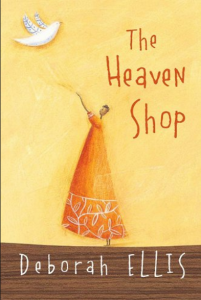
Ellis, Deborah. The Heaven Shop. Toronto: Fitzhenry & Whiteside, 2004.
Binti and her siblings are orphaned when their father dies of AIDS. Split up and sent to relatives all over Malawi, they suffer increasing hardship until they are reunited through the influence of their formidable grandmother. (OhioLINK) For mature readers due to the subject matter.
Falcone, Lucy. The Librarian’s Stories. Brooklyn, New York: POW!, 2020.
The National Library of Sarajevo was bombed in 1992 during the Bosnian War. Steven Galloway wrote about this tragedy in The Cellist of Sarajevo, a novel for adults. And now Lucy Falcone, a former children’s television writer, has written a picture book inspired by that novel. Every day, a librarian sits on a bench outside the burned-out library and reads a book aloud to give people hope and courage. Illustrated by Anna Wilson, this story about the power of stories is recommended for readers 7 to 11 years old.
Filipovic, Zlata. Zlata’s Diary : a Child’s Life in Sarajevo. New York: Scholastic, 1994.
This autobiography contains excerpts from the author’s diary which she began during the siege of Sarajevo when she was eleven years old.
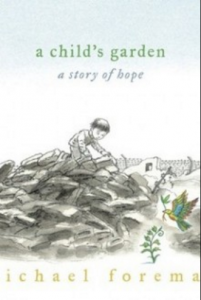
Foreman, Michael. A Child’s Garden: a Story of Hope. Candlewick Press, 2009.
Gibbons, Alan. Caught in the Crossfire. Orion Children’s Books, 2003.
Set in England, this suspense-filled novel shows what happens when the brother of a member of The Patriotic League starts secretly seeing a British Muslim girl. Fear, prejudice, pride and violence all combine to create a compelling novel for young adults.
Halilbegovich, Nadja. Childhood Under Fire. Toronto: KidsCanPress, 2008.
Illustrated with black and white photos, this is the diary of twelve-year-old Nadja who survived three years of war during the 1990s in Sarajevo.
Haworth, Danette. Me & Jack. New York: Walker & Co., 2011.
“During the Vietnam War, when twelve-year-old Josh and his Air Force recruiter father move to a small town in the mountains of Pennsylvania and get a dog from the local shelter, Josh is forced to stop hanging back and takes on the unfriendly town residents, a mountain, and the meanest boy in school.” – CIP This fast-paced novel is recommended for readers eleven to fourteen years old, especially ones who enjoyed Wild Life by Cynthia deFelice and Heart of a Shepherd by Rosanne Parry. [Bullies; Country life; Dogs; Fathers and sons; Friendship; Grief; Moving (Household); Pennsylvania; Post-traumatic stress disorder; Schools; Soldiers; Vietnam Conflict, 1961-1975]
Heneghan, James. Safe House. Victoria, B.C. : Orca Book Publishers, 2006.
Twelve-year-old Liam runs for his life after watching intruders kill his parents. The police hide him in a safe house, but a betrayal means he is on the run again. This easy-to-read novel for readers eleven years old and up vividly portrays the conflict between Protestants and Catholics in Belfast, Northern Ireland. [Northern Ireland; Violence; Murder; Orphans; Suspense]
Hof, Marjolijn. Against the Odds. Toronto: Groundwood, 2006.
Translated from German, this short award-winning novel tells the story of Kiki, whose father disappears while on a medical mission to help people in a war zone.
Humphries, Jessica Dee and Michel Chikwanine. Child Soldier: When Boys and Girls are Used in War. Toronto: Kids Can Press, 2015.
This graphic novel tells the true story of author Michel Chikwanine who came to Canada from the Democratic Republic of Congo in central Africa when he was 16 years old. Additional information and suggested resources for further research accompany this powerful autobiography recommended for readers 11 years old and up.
Jiang, Hi Li. Red Scarf Girl. Toronto: Scholastic, 1997.
In this memoir of the Chinese Cultural Revolution, the author tells of her young teen years when family members turned against each other, homes were searched by soldiers, and millions of people were imprisoned or killed.
Kalman, Bobbie. Refugee Child. St. Catherines, On.: Crabtree, 2006.
In this memoir of the 1956 Hungarian Revolution, the author describes seeing truckloads of dead and wounded people as she walked home from school one day. Soon, her family was on the run, crossing muddy fields and freezing water, hoping to escape the dogs and gunshots, hoping to get across the border to Austria.

Kass, Pnina Moed. Real Time. New York: Clarion Books, 2004.
“Sixteen-year-old Thomas Wanninger persuades his mother to let him leave Germany to volunteer at a kibbutz in Isarel, where he experiences a violent political attack and finds answers about his own past” – CIP Recommended for readers in grade 8 and up. [Israel; Holocaust; Arab-Israeli conflict; Voyages and travels; Terrorism]
Kephart, Beth. Going Over. San Francisco: Chronicle Books, 2014.
“In the early 1980s Ada and Stefan are young, would-be lovers living on opposite sides of the Berlin Wall–Ada lives with her mother and grandmother and paints graffiti on the Wall, and Stefan lives with his grandmother in the East and dreams of escaping to the West.” – CIP. Told from alternate points of view, this fast-moving novel is recommended for readers in grade 8 to 10. [Berlin; Germany; Graffiti; Historical fiction; Love stories; Young adult]
Khan, Rukhsana. The Roses in My Carpets. Markham, Ont.: Fitzhenry & Whiteside, 2004, c1988.
A young refugee boy learns to weave carpets so he can support his mother and sister after his father is killed by the fighting in Afghanistan. He escapes the horrors of his nightmares and the hunger and filth and danger of life in the camp by creating beautiful rugs and by praying. This emotionally intense picture book could be compared to How I Learned Geography by Uri Shulevitz and Silent Music by James Rumford. This picture book illustrated by Ronald Himler is highly recommended for readers 9 years old an d up. [Afghanistan; Dreams; Refugees]
Khan, Rukhsana. Wanting Mor. Toronto: Groundwood Book, 2009.
“Jameela feels relatively secure, sustained by her Muslim faith and the love of her mother, Mor. But when Mor dies, Jameela’s father impulsively decides to start a new life in Kabul where Jameela ultimately becomes an orphan after being abandoned in a busy marketplace by her father and stepmother. With only the memory of her mother to sustain her, Jameela finds the strength to face those who abandoned her when fate brings them together again.” – NVPL.
Lai, Thankha. Inside Out and Back Again. HarperCollins, 2011.
A ten-year-old girl tells of the journey she, her three brothers and her mother make from Vietnam to their new home in Alabama in 1975 after the fall of Saigon.
Laird, Elizabeth. The Garbage King. Macmillan Children’s Books, 2003.
Two teenaged runaways meet on the streets of Addis Ababa, the capital city of Ethiopia. Dani has run away from his wealthy father. Mamo, an orphan, has run away from the man who kidnapped him and sold him into slavery. Together, they find a way to survive with the help of other boys living in poverty. [Ethiopia; Runaways; Survival; Courage; Child abuse; Slavery; Homelessness; Friendship; Brothers and sisters]
Laird, Elizabeth. Oranges in No Man’s Land. London: Macmillan Children’s Books, 2006.
Ayesha lives in a battle-scarred building with her grandmother. Outside, a war is ripping the city apart — but Ayesha doesn’t even know why the two sides are fighting. Life gets even scarier when her grandmother’s medicine runs out. So Ayesha tales matters into her own hands — and in her search for a doctor makes the forbidden journey across no man’s land. (back cover)
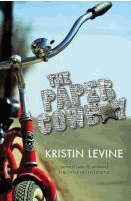
Levine, Kristin. The Paper Cowboy. New York: G. P. Putnam’s Sons, 2014.
“In a small town near Chicago in 1953, twelve-year-old Tommy faces escalating problems at home, among his Catholic school friends, and with the threat of a communist living nearby, but taking over his hospitalized sister’s paper route introduces him to neighbors who he comes to rely on for help.” – CIP. Based on the childhood of the author’s father, this quickly-paced but thought-provoking novel is highly recommended for readers 12-years-old and up. [Bullying; Child abuse; Communism; Conduct of life; Family problems; Friendship; Historical fiction; Illinois; Newspaper carriers]
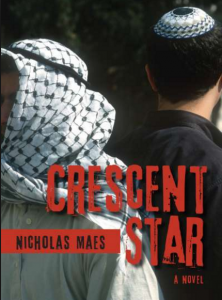
Maes, Nicholas. Crescent Star. Dundurn Press, 2011.
Mankell, Henning. Secrets in the Fire. Richmond Hill: Annick Press, 2003.
This novel is based on the true story of an young girl living in war-torn Mozambique who has to flee with her family through a jungle planted with landmines.
Mankell, Henning. Shadow of the Leopard. Toronto: Annick, 2007.
At the age of nine, Sofia lost her legs in a landmine explosion. She still lives in a village in Mozambique and is now expecting her third child. Her beloved Armando works in the city and comes home on Saturdays. Life is hard, but things become much worse when, one weekend, Armando does not return. (back cover) This sequel to Secrets in the Fire is for mature readers only due to subject matter.
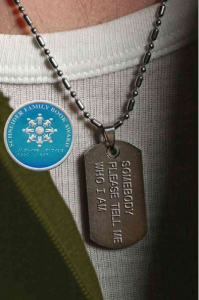
Mazer, Harry and Peter Lerangis. Somebody Please Tell Me Who I Am. New York: Simon & Schuster Books for Young Readers, 2012.
“Wounded in Iraq while his Army unit is on convoy and treated for many months for traumatic brain injury, the first person Ben remembers from his earlier life is his autistic brother.” – CIP. Recommended for reader s14-years-old and up. [Autism; Brain damage; Brothers; Iraq War, 2003]
Matthews, L.S. Fish. New York : Delacorte, 2004.
Tiger and his parents have to leave the village where they have been working. A drought is drying up the land, war is approaching, and their only hope is to escape across the mountains. So they set out with a guide. But events become more and more mysterious after Tiger finds a little fish in a mud puddle and determines to keep it alive until they all reach safety. This short but sophisticated story is for readers with imagination eleven years old and up.
McCormick, Patricia. Never Fall Down. New York : Balzer + Bray, 2012.
Arn is forced to serve as a child soldier in this vivid novel, based on a real story, by an accomplished author. It will be appreciated by mature readers in grades eight and up. [War; Survival; Cambodia; Soldiers; Genocide; Young adult fiction; Kidnapping]
McCormick, Patricia. Purple Heart. New York: Balzer + Bray, 2009.
While recuperating in a Baghdad hospital from a traumatic brain injury sustained during the Iraq War, eighteen-year-old soldier Matt Duffy struggles to recall what happened to him and how it relates to his ten-year-old friend Ali. (CIP) For mature readers only due to subject matter and language.
McKay, Sharon E. War Brothers. Toronto: Puffin Canada, 2008.
Jacob is the son of a wealthy landowner. Oteka has lost his parents to AIDS and is alone in the world. And Hannah, beaten but not defeated, holds the secrets of all the vanished children….[Their] destines become entwined as they find themselves in the clutches of the Lord’s Resistance Army, forced to march endlessly….The boys plan a group escape, but will…[they] survive? (back cover)
Miklowitz, Gloria D. The Enemy Has a Face. Grand Rapids, MI: Eerdmans Books for Young Readers, 2003.
Netta and her family have relocated temporarily from Israel to Los Angeles, and when her seventeen-year-old brother mysteriously disappears, she becomes convinced that he has been abducted by Palestinian terrorists. (OhioLink)
Myers, Walter Dean. Patrol: An American Soldier in Vietnam. New York: HarperCollins, 2002.
A frightened American soldier faces combat in the jungles of Vietnam in this picture book illustrated with collages.
 Myers, Walter Dean. Sunrise over Fallujah. New York : Scholastic Press, 2008.
Myers, Walter Dean. Sunrise over Fallujah. New York : Scholastic Press, 2008.
“Robin ‘Birdy’ Perry, a new army recruit from Harlem, isn’t quite sure why he joined the army, but he is sure of where he is headed: Iraq. Birdy and the others in the Civilian Affairs Battalion are supposed to help, secure and stabilize the country and successful interact with the Iraqi people. Officially the code name for their maneuvers is Operation Iraqi Freedom, but the young men and women in the CA unit have a simpler name for it: War.” Read this intriguing novel, Sunrise Over Fallujah by Walter Dean Myers and find out what thrilling and dangerous adventures Robin goes on. Will he survive? Or will he perish like many before him? Read this exciting novel to find out what will happen. – Ben in grade eight
Naidoo, Beverly. Burn My Heart. Amistad, 2009, c2007.
Matthew and Mugo have been friends for years even though Matthew is the son of a wealthy landowner and Mugo is a household servant. But everything changes when the Mau Mau uprising begins in 1950s Kenya. Everyone becomes afraid and violence is around every corner. Based on historical events, this novel will appeal to adventurous readers who like books about real life. [Kenya; Historical fiction; Friendship; Racism; Fathers and sons]
Naidoo, Beverley. The Other Side of Truth. London: Puffin Books, 2000.
Smuggled out of Nigeria after their mother’s murder, Sade and her younger brother are abandoned in London when their uncle fails to meet them at the airport; they are fearful of their new surroundings and of what may have happened to their journalist father back in Nigeria.
Nielsen, Jennifer A. A Night Divided. New York: Scholastic Press, 2015.
When the Berlin Wall went up, Gerta, her mother, and her brother Fritz are trapped on the eastern side where they were living, while her father, and her other brother Dominic are in the West–four years later, now twelve, Gerta sees her father on a viewing platform on the western side and realizes he wants her to risk her life trying to tunnel to freedom.” – CIP. Highly recommended for readers 11 to 16-years-old. [Berlin Wall; Courage; Germany; Secrets; Tunnels]

O’Brien, Tony. Afghan Dreams. New York: Bloomsbury Children’s Books, 2008.
Not a novel, this is a collection of brief interviews with “children of all ages and ethnic backgrounds and with very different daily lives. As each one tells his or her story, the reader is placed in the middle of everyday life as it is lived by the children of one of the world’s most enduringly conflict-ridden countries.” (flyleaf)
Oron, Judie. Cry of the Giraffe. Toronto: Annick Press, 2010.
Thirteen-year-old Wuditu and her family, Ethiopian Jews, set out for the Sudan, hoping to eventually reach safety in Israel. Instead, Wuditu ends up in a refugee camp and life as a slave. Will she ever be reuinited with her family? Based on a true story, this novel is for mature readers. [Ethiopia; Sudan; Jews; Refugees; Slavery; Historical fiction]
Park, Frances. My Freedom Trip: A Child’s Escape from North Korea. Honesdale, (Penn.): Boyds Mill Press, Inc., 1998.
 Parry, Rosanne. Heart of a Shepherd. New York: Random House 2009.
Parry, Rosanne. Heart of a Shepherd. New York: Random House 2009.
Ignatius “Brother” Alderman, nearly twelve, promises to help his grandparents keep the family’s Oregon ranch the same while his brothers are away and his father is deployed to Iraq, but as he comes to accept the inevitability of change, he also sees the man he is meant to be. – CIP [Iraq War, 2003; Faith; Family life; Christian life; Oregon; Ranch life; Grandfathers; Responsibility]
Paterson, Katherine. The Day of the Pelican. Boston: Clarion Books, 2009.
In 1998 when the Kosovo hostilities escalate, the life of thirteen-year-old Meli, an ethnic Albanian, changes forever after her brother escapes his Serbian captors and the entire family flees from one refugee camp to another until they are able to immigrate to America. (CIP)
Think of that one day where you did something wrong, the day you are pretty sure affected your whole future and those around you. Imagine your feelings: desperation, guilt, shame and a longing to go back and change that day. This is how Meli Lleshi from The Day of the Pelican by Katherine Paterson (Clarion Books, 2009) feels all the time after her family is forced to flee their city. She thinks that just because she drew a rude picture of her teacher, which led to her brother being beaten and jailed, the Serbians are going to attack her home and family. Even after, when they are in a refugee camp, safe and protected, her mind takes her back to that dreadful day where everything changed. Now they are in America and there is “a new beginning” as her father says, a new beginning of hope, peace and freedom. But even this does not last long. Soon after the 9/11 attack, everyone is paranoid and wicked glances are thrown in her direction and she is treated as if she is a terrorist, as if this is all her fault. Will her family ever fit in and go back to living a life of happiness? (Ilar in grade eight)
Paterson, Katherine. Park’s Quest. Markham, On.: Penguin, 1988.
Eleven-year-old Park wants to find out more about his father who was killed in combat in Vietnam. When he spends several weeks with his grandfather, he learns more about his father than he’d expected and discovers a half-sister whose mother is from Vietnam.
 Rumford, James. Silent Music: A Story of Baghdad. New York: Roaring Brook Press, 2008.
Rumford, James. Silent Music: A Story of Baghdad. New York: Roaring Brook Press, 2008.
In this picture book for adolescents, bombs and missiles fall on Baghdad while a boy uses the art of calligraphy to emotionally distance himself from the fighting.
Life lessons, I learned, can come from pretty much anywhere, whether it is my mom telling me to think ahead of what the weather will be like and to dress appropriately, or just me realizing I just did a stupid thing and telling myself, “Well, I’ll never do that again.” And many times I find those life lessons in books. Silent Music by James Rumford (Roaring Book Press, 2008) is one of the books from which I learned a good life lesson. At first, when I picked up this picture book, I didn’t know what to expect. All I knew was that I needed to sign out two picture books so this was the one I grabbed off the shelf. Well, I guess this was the right one to pick because in the few pages this book had, there was so much meaning that a whole novel could be written on it. Some of the things that I learned are that inspiration can lead to great things, and that in a time of depression, desolation and war, not losing yourself is one of the most important things that you can do. This story is set in Baghdad and is the tale of Ali, a young boy, who loves to play soccer and dance, but most of all loves practicing calligraphy. He is inspired by the great calligrapher Yakut and so, totally trapped in a country where war and poverty are all around, he turns to what he loves to bring peace to his heart and to his mind. This was truly an inspiring story. (Luisa in grade eight)
Aloha, Ms. Rosen,
Please tell Luisa of Eighth Grade that her essay on my SILENT MUSIC was one of the most thoughtful and well-presented I have ever read. Thank you for posting what she wrote.
Aloha,
James Rumford (jamesrumford.com)
Ruth, Greg. Coming Home. New York: Feiwel and Friends, 2014.
An almost wordless picture book depicting the joy of homecoming. [Children of military personnel; Mothers and sons; Soldiers]
Schmidt, Gary D. Just Like That. Boston: Clarion Books, Houghton Mifflin Harcourt, 2021.
Meryl Lee is sent to a posh boarding school in Maine where wealthy students are clearly considered superior. Unfortunately, she is not wealthy enough. Matt has run away – with a pillowcase full of money – from a criminal gang and is hiding in a seaside shack. The two teenagers – each struggling to survive despite heart-breaking losses – meet and begin a friendship. Set in 1968 during the Vietnam war, this young adult novel addresses political issues, Christian beliefs, and social justice. Highly recommended for readers 12 years old and up. (P.S. Everything written by Gary D. Schmidt is worth reading.)
Sis, Peter. The Wall. New York: Frances Foster Books, 2007.
Annotated illustrations, journals, maps, and dreamscapes take readers on an extraordinary journey of how the artist-author’s life was shaped while growing up in Czechoslovakia during the Cold War, as well as the influence of western culture through the influx of banned books, music, and news, in a powerful graphic memoir. (FVPL)
 Stratton, Allan. Chanda’s Wars. Toronto: HarperCollins, 2008.
Stratton, Allan. Chanda’s Wars. Toronto: HarperCollins, 2008.
Chanda Kabelo, a teenaged African girl, must save her younger siblings after they are kidnapped and forced to serve as child soldiers in General Mandiki’s rebel army. This vivid fictional account is for mature readers only due to the subject matter.
Tilly, Meg. Porcupine. Toronto: Tundra Books, 2007.
War-torn Afghanistan could not seem farther from Newfoundland, but it is about to change twelve-year-old tomboy Jack Cooper (or Jacqueline, as her mother insists on calling her) forever. When her father is killed in the war, she watches helplessly as her mother crumbles under sorrow and depression. (NVPL)
Walters, Eric. Shattered. Toronto: Puffin Canada, 2008.A teenage boy from a wealthy home, volunteering in a poor area of Vancouver, B.C. in order to meet high school graduation requirements, meets a homeless soldier who has returned from the massacre in Rwanda and learns about the plight of victims of war. Includes a forward by Lieutenant General Romeo Dallaire.
Walters, Eric. We All Fall Down. Toronto: Seal Books, 2006.
Will, a ninth-grader, spends September 11 at his father’s workplace in New York City. He thinks his father won’t have much time for him, but everything changes when a plane flies into the building and the two of them have to escape.
Walters, Eric and Adrian Bradbury. When Elephants Fight. Victoria: Orca, 2008.
This non-fiction book “presents the stories of five children…from five very different and distinct conflicts — Sri Lanka, Uganda, Sarajevo, Afghanistan and the Sudan. Along with these very personal accounts, the book also offers brief analyses of the history and geopolitical issues that are the canvas on which these conflicts occur.” — back cover
 Whelan, Gloria. The Disappeared. New York: Dial Books, 2008.
Whelan, Gloria. The Disappeared. New York: Dial Books, 2008.
What if you are trying to save your brother who has been kidnapped? What will you do if the kidnappers are part of the 1970s government in Argentina?
Williams, Karen Lynn and Khadra Mohammed. Four Feet, Two Sandals. Grand Rapids, Mich. : Eerdmans Books for Young Readers, 2007.
“Two young Afghan girls living in a refugee camp in Pakistan share a precious pair of sandals brought by relief workers.” – CIP. When Lina and her family finally are allowed to leave, she gives the sandals to Feroza, telling her that some day they will share again in America. A quietly touching picture books, with full page colour illustrations by Doug Chayka and an afterward by the authors. Recommended for readers 7 to 13 years old. [Pakistan; Refugee camps; Refugees; Sharing]
Williams, Michael. Diamond Boy. New York: Little, Brown and Co., 2014.
“When Patson’s family moved to the Marange region of Zimbabwe he begins working in the mines, searching for blood diamonds, until government soldiers arrive and Patson is forced to journey to South Africa in search of his missing sister and a better life.” – CIP. [Brothers and sisters; Child labor; Diamonds; Mines and mining; Runaways; Shona (African people); Zimbabwe]
…
Williams, Michael. Now Is the Time for Running. New York : Little, Brown, 2013, c2009.
“When soldiers attack a small village in Zimbabwe, Deo goes on the run with Innocent, his older, mentally disabled brother, carrying little but a leather soccer ball filled with money, and after facing prejudice, poverty, and tragedy, it is in soccer that Deo finds renewed hope.” – CIP. Recommended for more mature readers. [Brothers; Homelessness; People with mental disabilities; Refugees; Soccer; Zimbabwe]
Winter, Jeannette. Nasreen’s Secret School. New York: Beach Lane Books, 2009.
[This picture book tells a true story from Afghanistan.] Young Nasreen has not spoken a word to anyone since her parents disappeared. In despair, her grandmother enrolls her in a secret school for girls. Will a devoted teacher, a new friend, and the worlds she discovers in books be enough to draw nasreenout of her shell of sadness? (flyleaf)
Did you know that Afghan women were not allowed to go outside without a male chaperone? Did you know that Afghan girls were not allowed to go to school? Nasreen’s Secret School by Jeanette Winter (Beach Lane Books, 2009) is a fascinating book about what happened when the Taliban took over Afghanistan. I learned that all women had to wear a burqa that covered their whole body and that the Taliban did not want the women and the girls to learn about the world. I discovered that women were treated unfairly and that the Taliban were cruel terrorists. Nasreen’s Secret School by Jeanette Winter is an excellent book on how the Afghans lived when the Taliban took control of Afghanistan. (Daniel C.)
Winter, Jeanette. September Roses. New York: Farrar Straus Giroux, 2004.
“On September 11, 2001, two sisters from South Africa find a good use for the roses they have grown when the flower show in New York City is canceled due to the attack on the World Trade Center.” – CIP. This small picture book is recommended as a read-aloud and discussion starter for grades 3 and up. [Gardens; New York (City); Roses; September 11 Terrorist Attacks, 2001; Sisters]
Woodson, Jacqueline. Peace, Locomotion. New York: G.P. Putnam’s Sons, 2009.
“Through letters to his little sister, who is living in a different foster home, sixth-grader Lonnie, also known as “Locomotion” keeps a record of their lives while they are apart, describing his own foster family, including his foster brother who returns home after losing a leg in the Iraq War.” – CIP. Highly recommended for readers 11 to 16 years old. [African Americans; Brothers and sisters; Foster children; Letters; Orphans; Peace; War]
Ye, Tian-xing. My Name is Number 4. N.p.: Random House of Canada, 2008.
This is the true story of a girl during the Chinese Cultural Revolution, a teenager who endured hunger, poverty, attacks by the Red Guards and even exile on a farm prison far from home.
Yelchin, Eugene. Spy Runner. New York: GodwinBooks, Henry Holt and Company, 2019.
In 1953 America, 12-year-old Jake is keeping his eyes open for Russian spies. His father has been missing in action since the end of the war in 1945, so when his mother invites a mysterious boarder into their home, he is suspicious. Why do the stories about his father not make sense? Why is his mother so affectionate toward this new man? Why is his principal so afraid of two strange men who visit the school? What is going on? This dramatic page-turner – evoking all the secrecy and paranoia of the Cold War – will appeal to curious readers 11 years old and up. [Communism; Cold War; Russia; Spies]
Zenatti, Valerie. A Bottle in the Gaza Sea. Bloomsbury Publishing, 2008.
Tal, a teenager in Tel Aviv, throws a bottle in the sea after witnessing a bombing. Soon, she receives an email message from a Palestinian young man and slowly, a friendship develops between them.
Click HERE for more stories of refugees due to recent conflicts.
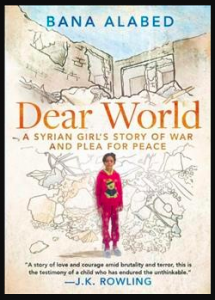
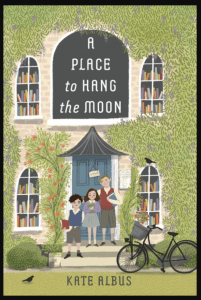

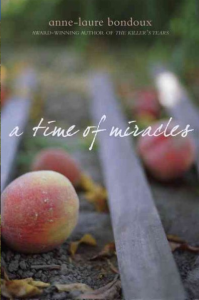



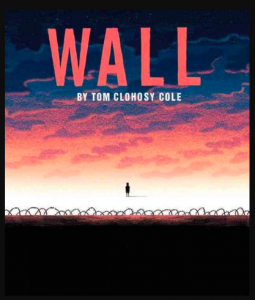




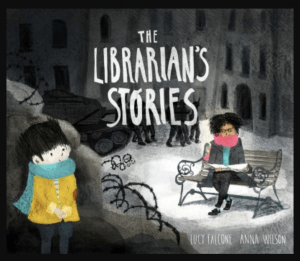



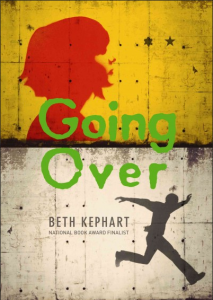
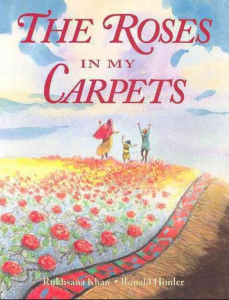

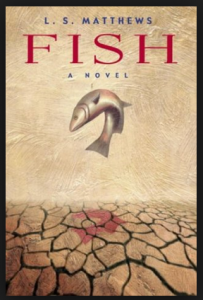

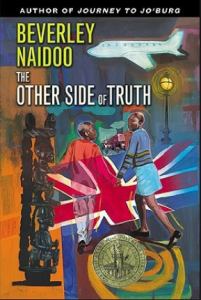
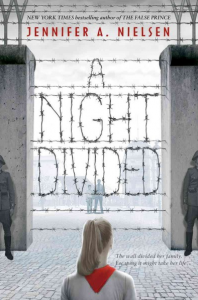
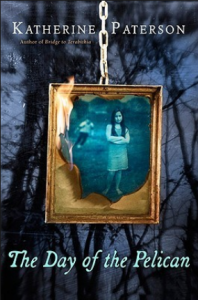
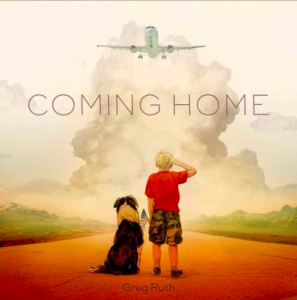
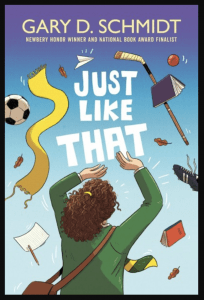

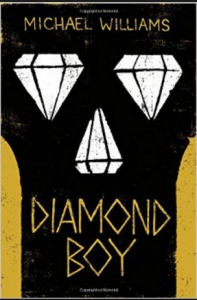
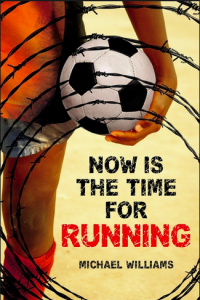
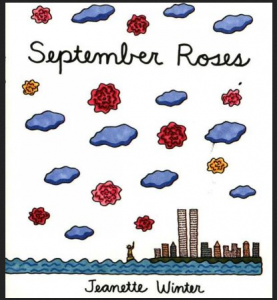
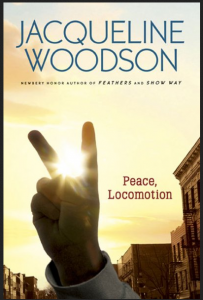
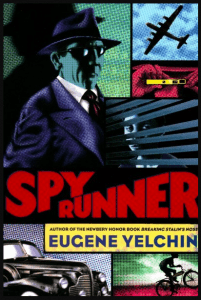


All of these are very wonderful books.
I’m glad you appreciated the books about WW2. You might enjoy reading these stories about wars after 1945, too. Novels are a powerful way to learn about what life has been like for people in the past. You learn now only the facts but the feelings of human experiences.
These are really good WW2 books.